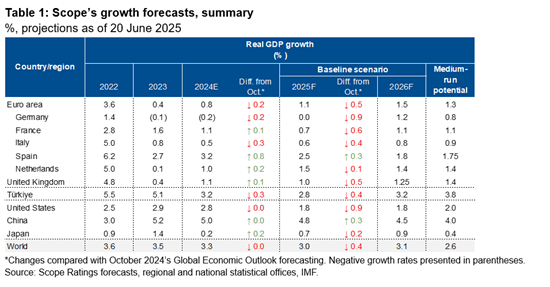Announcements
Drinks

Global Economic Outlook: US, Europe grow more slowly than expected amid trade, geopolitical tensions
The European rating agency has revised its forecast for US growth to 1.8% this year from a previous forecast of 2.7% last October (Table 1), while forecasting growth of 1.8% in 2026. US output rose 2.8% last year.
“Our forecast is for global growth to slow to 3.0% in 2025 from 3.3% in 2024 before continuing at a moderate rate of 3.1% next year,” says Dennis Shen, Chair of Scope’s Macroeconomic Council and lead author of the mid-year 2025 review of Scope’s Global Economic Outlook published Friday, 20 June. Download the report here.
“Medium-term macro risks remain negatively skewed. We forecast that interest rates will remain above the pre-pandemic levels amid structurally higher inflation,” Shen says.
“The cut to US growth forecasts for this year comes amid trade uncertainties and cuts in government spending by the Department of Government Efficiency,” Shen says.
Germany to recover after consecutive years of stagnant growth by 2026
As regards Germany, Scope forecasts no growth this year compared with a forecast last October of 0.9% – the economy contracted 0.2% in 2024 – but sees output in Europe’s largest economy expanding by 1.2% next year.
Germany’s sluggish performance this year will drag euro-area growth to a less-than-expected 1.1%, 0.5pps below Scope’s former forecast, before a slight rebound in 2026 to 1.5%.
Spain and economies of the euro-area periphery – such as Greece, Ireland, Portugal – continue to outperform the rest of the euro area. Spain’s forecast growth this year of 2.5%, revised up by 0.3pps, contrasts with France’s of 0.7%, cut 0.6pps, and Italy’s of 0.6%, revised down by 0.4pps.

Defence, infrastructure spending to underpin stronger 2026 growth in Europe
“We foresee stronger growth in Europe in 2026 as defence spending rises and governments implement measures to increase investment,” Shen says.
Looking ahead, Scope sees four adverse factors weighing on the outlook for the global economy and global credit. First, there are the on-again, off-again escalations and de-escalations of trade tensions posing recessionary risks for the global economy. Secondly, threats are increasing for financial stability amplified by the latest wave of financial deregulation spear headed by the United States.
“Another factor is the budgetary challenges that governments face, triggering more frequent market re-appraisals of sovereign debt risks. Finally, there are heightened geopolitical risks, not least Russia’s continuing war in Ukraine and the recent escalation of conflict between Israel and Iran,” says Shen.
“We assume higher steady-state borrowing rates than the rates that prevailed before the cost-of-living crisis. Many central banks have paused rate reductions, even if the Federal Reserve and Bank of England may resume them later this year whereas the Bank of Japan is gradually increasing rates. Sustained higher borrowing rates and elevated financial-market valuations amid financial deregulation threaten corrections and present risks for financial stability and global credit conditions,” he says.
Related material:
Report: Scope’s 2025 mid-year global economic outlook
Presentation: Scope's 2025 mid-year economic and credit outlook
Video: Scope introduces the 2025 mid-year economic outlook
Webinar replay: Where is the global economy headed amid global tariff uncertainty?
Data: Scope's mid-year 2025 economic projections
*The Scope Macroeconomic Council brings together credit opinions from ratings teams across multiple issuer classes: sovereign and public sector, financial institutions, corporates, structured finance and project finance.






